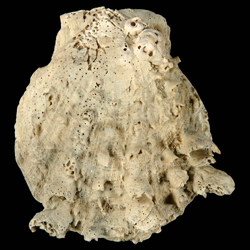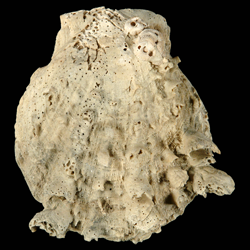
Spondylidae

- Phylum: Mollusca
- Class: Bivalvia
- Order: Pectinida
- Family: Spondylidae
Overview
Common name: Spondylids, thorny oysters, and spiny oysters
Key morphological features: The Spondylidae range in size to over 200mm in size. The shells are often vibrant in color and inequivalve, with a larger and more inflated right valve than left. There is intraspecific variability, but the shells are generally subcircular, and have small anterior and posterior auricles. A byssal notch is present in juveniles, but unlike the Pectinidae, it lacks ctenolium. The shell is composed of a combination of aragonite and calcite, and exterior sculpture consists of thin radial ribs and radial lines of prominent, blunt spines. The Spondylidae live permanently attached to hard substrates, so the shell exterior also has an attachment scar near the umbo, always on the right valve. Valve interiors have a simple, uninterrupted pallial line and the interior shell margins are denticulated. Species of Spondylidae are monomyarian, having only a posterocentrally positioned posterior adductor muscle as adults. The hinge features a trigonal resilifer flanked by prominent secondary isodont teeth and the cardinal area is large, but unequal between valves—it is large and trigonal in the right (lower) valve and smaller and shallowly trigonal on the left (upper) valve. Source: Mikkelsen, P.M., and Bieler, R. 2008. Seashells of Southern Florida: Bivalves. Princeton, New Jersey: Princeton University Press. 503 pp.
Geological range: Jurassic to Recent (Mikkelsen & Bieler, 2008).
Geographic distribution: A distributional map for modern Spondylidae may be accessed from OBIS. A distributional map for ancient Spondylidae may be accessed from the Paleobiology Database.
Diversity: There are 67 recognized living species of Spondylidae and 1 genus (WoRMS database, unvetted). The Paleobiology Database recognizes 1 fossil genus and 149 fossil species of Spondylidae (unvetted).
Paleoecology: The Spondylidae are marine, filter-feeding bivalves that live permanently cemented to hard substrates. Their spinose exteriors are often host to encrusting sponges and other epibionts that help camouflage the clam. They can be found in tropical and subtropical waters worldwide including a range of depths from shallow to very deep. Source: Mikkelsen and Bieler (2008).
Phylogenetic status: There is only one genus in Family Spondylidae.
